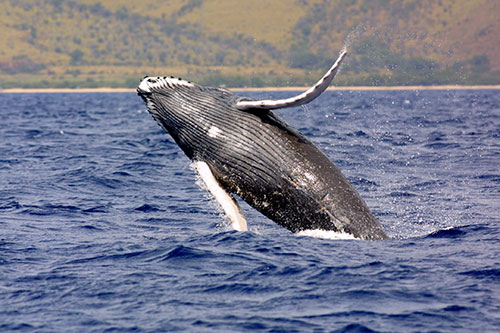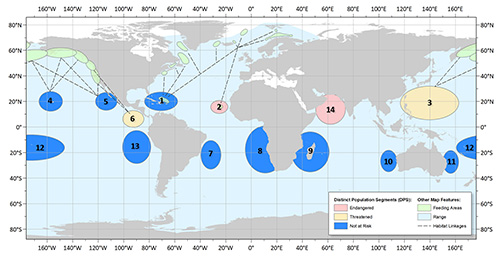
ESA Humpback Whale Listing Revised
April 20, 2015
The humpback whale is currently listed as endangered throughout its range. The proposed rule finds that ten of those 14 populations do not warrant ESA listing. While commercial whaling severely depleted humpback whale numbers, population rebounds in many areas result in today’s larger numbers, with steady rates of population growth since the United States first listed the animal as endangered in 1970.
NOAA's proposal to reclassify humpback whales into 14 distinct population segments will offer fisheries managers a more tailored conservation approach.
NOAA Fisheries initiated an extensive review of the status of humpback whales in 2010, the results of which support separating the species into distinct population segments. The review also finds that many of the populations are not in danger of extinction (endangered) or likely to become so in the foreseeable future (threatened). “The return of the iconic humpback whale is an ESA success story,” said Eileen Sobeck, assistant NOAA administrator for fisheries. “As we learn more about the species -- and realize the populations are largely independent of each other -- managing them separately allows us to focus protection on the animals that need it the most.” For a larger image, click here or on the map -- Approximate locations & feeding grounds of proposed humpback whale distinct population segments: 1. West Indies, 2. Cape Verde Islands/Northwest Africa, 3. Western North Pacific, 4. Hawaii, 5. Mexico, 6. Central America, 7. Brazil, 8. Gabon/Southwest Africa, 9. Southeast Africa/Madagascar, 10. West Australia, 11. East Australia, 12. Oceania, 13. Southeastern Pacific, 14. Arabian Sea.
NOAA Fisheries is opening up a 90-day public comment period for this proposed rule. During this time, NOAA Fisheries welcomes public comments and any new information to ensure that our final determination is based on the best available scientific and commercial information. You may submit comments, information, or data on this document, identified by the code NOAA-NMFS-2015-0035, by any of the following methods:
Edited by Mary Kauffman, SitNews
On the Web:
Source of News:
|
||

